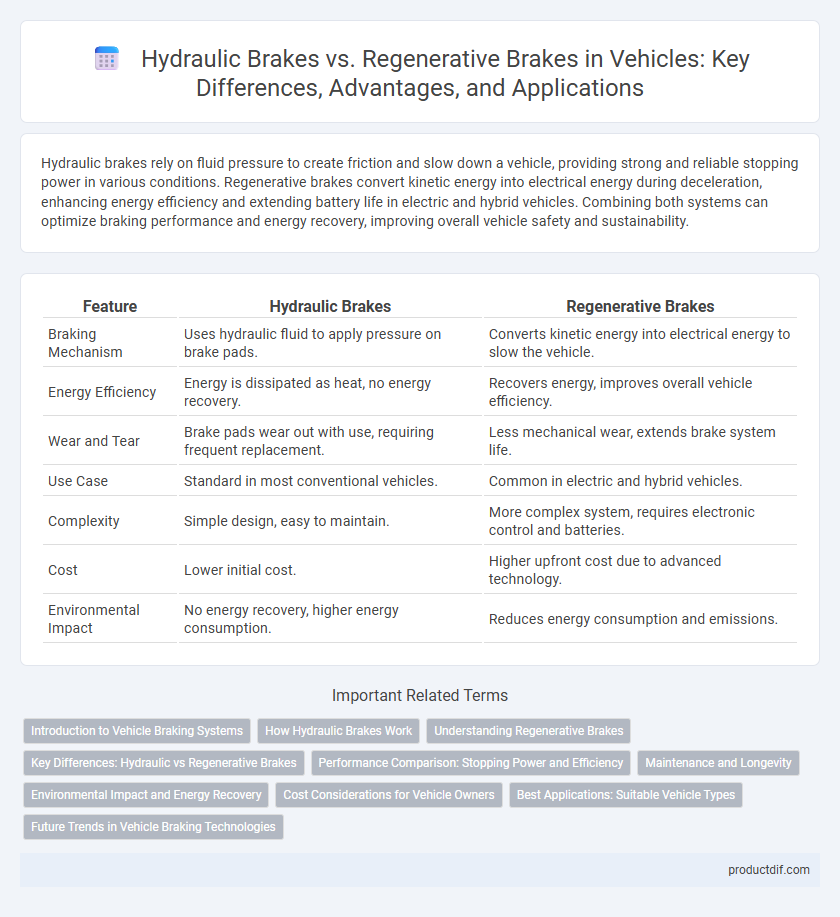Hydraulic brakes rely on fluid pressure to create friction and slow down a vehicle, providing strong and reliable stopping power in various conditions. Regenerative brakes convert kinetic energy into electrical energy during deceleration, enhancing energy efficiency and extending battery life in electric and hybrid vehicles. Combining both systems can optimize braking performance and energy recovery, improving overall vehicle safety and sustainability.
Table of Comparison
| Feature | Hydraulic Brakes | Regenerative Brakes |
|---|---|---|
| Braking Mechanism | Uses hydraulic fluid to apply pressure on brake pads. | Converts kinetic energy into electrical energy to slow the vehicle. |
| Energy Efficiency | Energy is dissipated as heat, no energy recovery. | Recovers energy, improves overall vehicle efficiency. |
| Wear and Tear | Brake pads wear out with use, requiring frequent replacement. | Less mechanical wear, extends brake system life. |
| Use Case | Standard in most conventional vehicles. | Common in electric and hybrid vehicles. |
| Complexity | Simple design, easy to maintain. | More complex system, requires electronic control and batteries. |
| Cost | Lower initial cost. | Higher upfront cost due to advanced technology. |
| Environmental Impact | No energy recovery, higher energy consumption. | Reduces energy consumption and emissions. |
Introduction to Vehicle Braking Systems
Hydraulic brakes use fluid pressure to transfer force from the brake pedal to the brake pads, providing reliable stopping power in traditional vehicles. Regenerative brakes convert kinetic energy into electrical energy during deceleration, improving energy efficiency in electric and hybrid vehicles. Vehicle braking systems integrate both types to enhance safety and optimize energy recovery.
How Hydraulic Brakes Work
Hydraulic brakes operate by converting the force applied on the brake pedal into hydraulic pressure through brake fluid, which then activates the brake calipers to press the brake pads against the rotors, creating friction that slows the vehicle. This hydraulic system ensures consistent braking force distribution and rapid response times, essential for vehicle safety. Unlike regenerative brakes, hydraulic brakes rely on mechanical friction rather than energy recovery, making them indispensable in most conventional and high-performance vehicles.
Understanding Regenerative Brakes
Regenerative brakes capture kinetic energy during deceleration and convert it into electrical energy, which is stored in the vehicle's battery for later use, enhancing overall energy efficiency. Unlike hydraulic brakes that rely on friction to slow down the vehicle and dissipate energy as heat, regenerative braking reduces wear on brake components and improves range, especially in electric and hybrid vehicles. This technology plays a crucial role in sustainable transportation by optimizing energy recovery and reducing reliance on conventional braking systems.
Key Differences: Hydraulic vs Regenerative Brakes
Hydraulic brakes use fluid pressure to engage brake pads and create friction for stopping, providing consistent and reliable braking power in all conditions. Regenerative brakes convert kinetic energy into electrical energy, recharging the vehicle's battery while reducing wear on mechanical components. Unlike hydraulic brakes, regenerative systems enhance energy efficiency but may require hydraulic brakes for complete stopping power.
Performance Comparison: Stopping Power and Efficiency
Hydraulic brakes provide consistent and strong stopping power through fluid pressure, ensuring reliable performance in all driving conditions. Regenerative brakes improve efficiency by converting kinetic energy into electrical energy during deceleration, but typically offer less immediate stopping force compared to hydraulic systems. Combining both brake types in modern vehicles enhances overall safety and energy conservation without compromising braking performance.
Maintenance and Longevity
Hydraulic brakes require regular fluid replacement and brake pad inspections to prevent wear and maintain optimal performance, with components typically needing replacement every 30,000 to 70,000 miles. Regenerative brakes reduce wear on traditional braking components by converting kinetic energy into electrical energy, significantly extending the lifespan of brake pads and lowering maintenance costs. Vehicles equipped with regenerative braking systems benefit from enhanced longevity and reduced maintenance frequency, contributing to overall cost efficiency.
Environmental Impact and Energy Recovery
Hydraulic brakes rely on friction to slow vehicles, causing brake pad wear that generates particulate pollution harmful to air quality. Regenerative brakes recover kinetic energy during deceleration, converting it into electrical energy stored in batteries, significantly reducing energy waste and lowering carbon emissions. This energy recovery process enhances overall vehicle efficiency and supports sustainable transportation by minimizing reliance on conventional fuel consumption.
Cost Considerations for Vehicle Owners
Hydraulic brakes generally involve lower upfront costs and simpler maintenance due to their established technology and widespread availability of parts. Regenerative brakes, while potentially more expensive initially because of advanced components and integration with electric drivetrains, can reduce long-term expenses by decreasing wear on brake pads and improving energy efficiency. Vehicle owners must weigh the initial investment against potential savings in maintenance and fuel or energy consumption when choosing between these braking systems.
Best Applications: Suitable Vehicle Types
Hydraulic brakes are best suited for heavy-duty vehicles like trucks and buses due to their powerful stopping force and reliable performance under extreme conditions. Regenerative brakes are ideal for electric and hybrid vehicles, as they efficiently recover energy during braking to extend battery life and improve overall efficiency. Passenger cars and light commercial vehicles commonly use a combination of both systems to maximize safety and energy conservation.
Future Trends in Vehicle Braking Technologies
Hydraulic brakes remain reliable for high-performance stopping power, but regenerative brakes are increasingly favored in electric and hybrid vehicles for energy recovery and improved efficiency. Future trends emphasize integration of advanced materials and smart sensors to enhance brake responsiveness and durability. Emerging technologies focus on seamless switching between hydraulic and regenerative systems to maximize safety and sustainability in vehicle braking.
Hydraulic brakes vs Regenerative brakes Infographic

 productdif.com
productdif.com